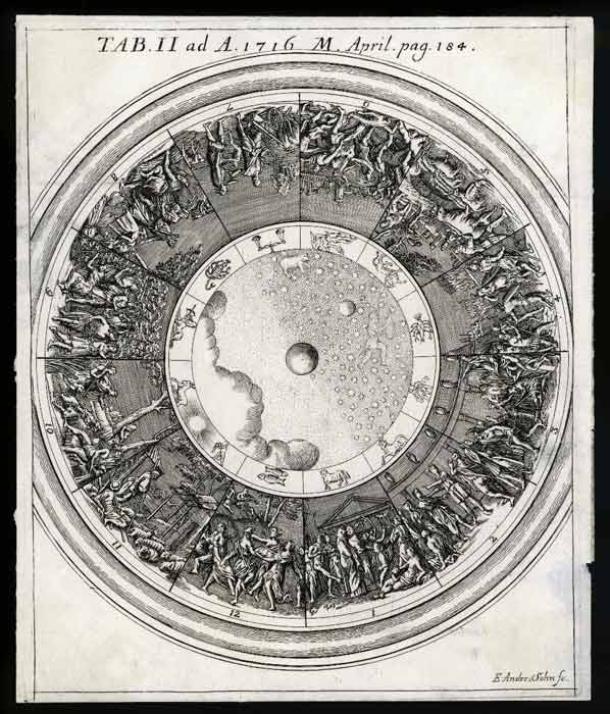
Achilles’ Shield: What’s the Meaning of the Iliad’s Most Symbolic Object?
The Iliad is one of the most famous epic poems created by the Greek poet Homer and the piece recounts the last weeks of the Trojan War. In book 18 of the series, Homer writes about Achilles’ shield - this poem is one of the epic's most famous portions. This part of the epic also provides one of the first known uses of ekphrastic (a vivid description of a scene or artwork) in Greek poetry. Achilles’ heel might be more popular than his armor - but Achilles’ shield offers more of an insight into ancient Greek society.
Homer and His Epic Poems
Homer is known as one of the great creators of epic poems. Two of his most famous pieces are the Iliad and the Odyssey. Homer was born circa 800 BC in Greece, which is where he also died, around 701 BC, however, historians are uncertain of the exact dates.
Both of his famous pieces, the Iliad and the Odyssey, offer insight into Greek society and how people lived, especially with the Trojan War’s influence.
Homer dedicated 134 lines in the Iliad to the creation and description of Achilles’ armor and shield. The section detailing his shield has been used to influence other creations - the poem “The Shield of Achilles” by W. H. Auden in 1952 and J.R.R. Tolkien’s novel The Fall of Gondolins.
Homer’s works changed the way ancient Greeks viewed the gods and promenade figures, and his writing gave the gods human-like characteristics. The Iliad influenced not only poems and literature but also social history. Herodotus was an ancient Greek historian and he said that Homer “gave the gods their names, and determined their spheres and functions, and described their outward forms.”

An interpretation of the Shield of Achilles by Angelo Monticelli c. 1820. (Public Domain)
The Iliad
Achilles had loaned his armor to his friend Patroclus to fight against Hector of the Trojans. Hector would kill Patroclus and take Achilles' armor for himself - a sign of disrespect in ancient Greece. After Achilles lost his armor and his friend to the hands of Hector, it fueled a wave of anger within Achilles. In the Iliad, Achilles proclaims, “How can I go up into the battle? They have my armour.”
- Homer’s Iliad Casts Doubt on the Aegean Location of Troy
- Toxic Masculinity Fostered by Misreadings of the Classics
Achilles’ mother, Thetis, a sea-nymph, knew her son needed a new shield after it was captured and asked the smith-god Hephaestus to create a new suit of armor. The Iliad describes the process of creating Achilles’ shield:
“First of all he forged a shield that was huge and heavy, elaborating it about, and threw around it a shining triple rim that glittered, and the shield strap was cast of silver. There were five folds composing the shield itself, and upon it, he elaborated many things in his skill and craftsmanship.”

‘Thetis Bringing Armor to Achilles’ (1806) by Benjamin West. (Public Domain)
It was culturally crucial for Achilles to defend his honor and kill the man that took his prized armor and shield. Primarily because of Achilles' status as a notable warrior, any sign of weakness could affect how his troops and society viewed his leadership.
The Many Symbols of Greek Society on Achilles’ Shield
In Homer’s vivid description of Achilles’ shield, he describes the eight circles that make up the circular shield. These eight circles created by Hephaestus are believed to showcase and represent contemporary Greek society, with the idea that this society is made up of happy people. The first and innermost circle is said to be comprised of “the earth, the heavens, and the sea; the moon also at her full and the untiring sun.”
The second to fifth circle detail social life in Greek society, and the second circle shows two cities, “fair to see and busy with the hum of men.” One has a wedding and the other is in a battle. Homer compares the two towns’ experiences – one happy and the other in turmoil.
The third circle details the plowing of fields, while the fourth explains that a king’s estate was reaped. Having fields of crops is vital for any society to flourish and thrive, and crime is inevitable, including stealing.

Achilles’ Shield. (Archivist/Adobe Stock)
Similar to plowing fields of grain, grapes and vineyards were essential to ancient Greek society and they are represented in the fifth circle. Wine was a standard beverage used in Greek households and Achilles’ shield shows another example of the fruitfulness of society, with Homer describing the image as “Maidens all blithe and full of glee, carried the luscious fruit in plaited baskets.”
The sixth circle portrays the darker side of society. This part of Achilles’ shield is described as a scene of a lion attacking a bull, while the farmers and their dogs stand by, unable to help. Losing cattle could result in a farmer’s inability to feed his family and to sell goods. The dogs could protect their masters, but neither were able to protect the bull. Homer writes:
“The lions tore through the bull’s thick hide… but the herdsmen were afraid to do anything… the dogs dared not fasten on the lions but stood by barking and keeping out of harm’s way.”

Detail of lions attacking a bull on the Shield of Achilles, 1823. (koopman rare art)
The seventh circle highlights a sheep farm, while the eighth and largest circle showcases a dance floor. This last circle has the most detail and Homer even describes what the young women and men were wearing at the dance: “The girls were crowned with garlands, while the young men had daggers of gold that hung by silver baldrics; sometimes they would dance deftly in a ring with merry twinkling feet.”
A Deeper Understanding of the Shield
In ancient Greece armor was a symbol of honor and status, and shields made with more precious metals provided their owners with more respect. A warrior stripped of their armor was also thought to have been stripped of their honor – which explains why Achilles was so distraught over his loss.
Achilles’ shield represents different sides of Greek society, for example some people are warriors while others are artisans or farmers. In order for a society to thrive, it needs both warriors and farmers - people need to be both fed and protected.
- Death and Glory: Heroes in Search of Kleos
- Achilles and Patroclus: Close Confidants or Passionate Paramours?
It also shows that society can alternate between war and peace and that some parts of society are complicated and difficult while others are fruitful and happy. This idea is demonstrated in the second circle with its happy portrayal of marriage and dancing and the contrasting fourth circle’s darker side of society, with the reaping of the king’s estate.

Detail of one of the outer circle on the Shield of Achilles, 1823. (koopman rare art)
The two cities represented on Achilles’ shield may represent Troy and Aigion - the cities of the Trojans and Achaeans (Greeks), respectively. The Trojans and the Greeks fought against each other in the Trojan War and it appears as though Homer believes that the Greeks fought for their honor and glory, while the Trojans fought for their safety.
Achilles’ shield depicts everyday life and also life during war, showing that war is only one part of life. Although a god created the shield, it did not make Achilles invincible like a god - famously Achilles’ heel was the downfall of this warrior. This is a critical reminder that humans are not gods and life is not guaranteed.
Top Image: The Shield of Achilles, 1823. Source: koopman rare art
By Sarah Piraino
References
Alexander, C. (2018) ‘What Homer’s Iliad can tell us about worship and war.’ BBC Culture. Available at: https://www.bbc.com/culture/article/20180428-what-homers-iliad-can-tell-us-about-worship-and-war
Aslam, Mariya & Scholar. (2016). ‘The Shield of Achilles: A Comparative Study.’ ResearchGate. Available at: https://www.researchgate.net/publication/328092568_The_Shield_of_Achilles_A_Comparative_Study
Brouwers, J. (2015) ‘The shield of Achilles.’ Ancient World Magazine. Available at: https://www.ancientworldmagazine.com/articles/the-shield-of-achilles/
Classical Literature. (n.d.) ‘The Iliad – Homer – Poem: Story, Summary & Analysis.’ Classical Literature. Available at: https://www.ancient-literature.com/greece_homer_iliad.html
Course Hero. (2016) ‘The Iliad| Study Guide.’ Course Hero. Available at: https://www.coursehero.com/lit/The-Iliad/symbols/#:~:text=The%20most%20symbolic%20object%20in,scenes%20of%20war%20and%20peace.&text=Achilles's%20shield%20is%20also%20invulnerable%20to%20attack
Homer. (c. 600 BC) ‘Iliad.’ Available at: https://www.planetebook.com/the-iliad/
GreeceHighDefinition. (2020) ‘The legendary shield of Achilles, for which Homer dedicated 134 verses of the Iliad.’ GreeceHighDefinition. Available at: https://www.greecehighdefinition.com/blog/the-shield-of-achilles?fbclid=IwAR001Kip9Afn1ncImMDK0jOVdSUsLk_6ryoqRsA_M3uCwkewqAZ51jmogs0
SparkNotes. (2021) ‘The Iliad.’ SparkNotes. Available at: https://www.sparknotes.com/lit/iliad/symbols/
















Comments
The BIG question is, was Homer just the modern equivalent of a daytime soap opera, basically just an evolving fictional sequence involving a lot of established characters, with ZERO basis in truth? Almost certainly! His works weren’t even well-known until the 15th-Century, and most earlier evidence of their existence is questionable. So, Herodotus credits Homer with essentially creating the imagery of the ancient Greek gods, but Herodotus himself is often referred to as ‘the father of lies.’ So if there are lies to be laid down by these works, which are widely studied and referenced, what might be the BIG one? That the ancient Greeks were as warlike as the Persians and Romans? That’s a big stretch. How does a culture, based on the morality of the Golden Rule, create beautiful megalithic stone complexes while at war? And of course no recognition of the pre-Ice Age Atlantean culture, wiped out circa 115k BC, adding the zero back to Plato's timeline.
Nobody gets paid to tell the truth.
This is a great post, full of excellent historical resources! You may be interested to see a modern reconstruction and full exploration of Achilles' Shield based literally on Homer's description. https://theshieldofachilles.net/appearance/
My book, Reconstructing the Shield of Achilles is available on Amazon at: https://www.amazon.com/Reconstructing-Shield-Achilles-Kathleen-Vail/dp/0...
and skips the most important astrological part of the shield.